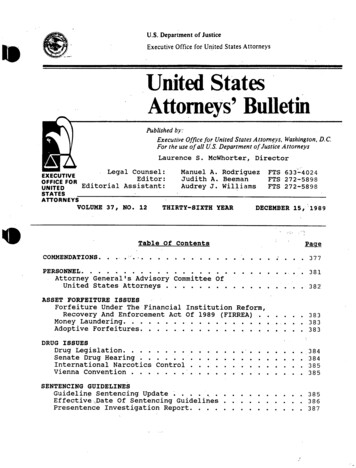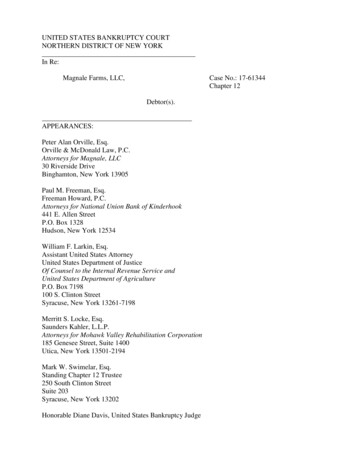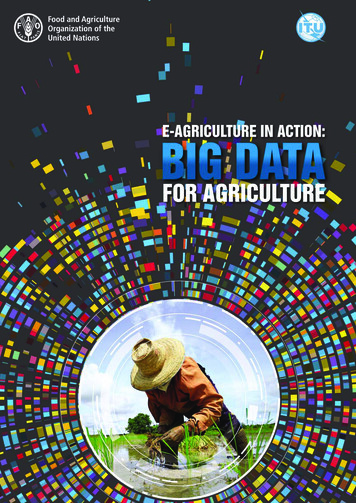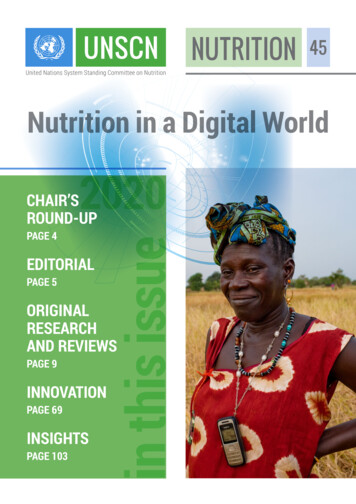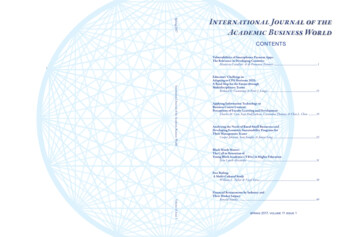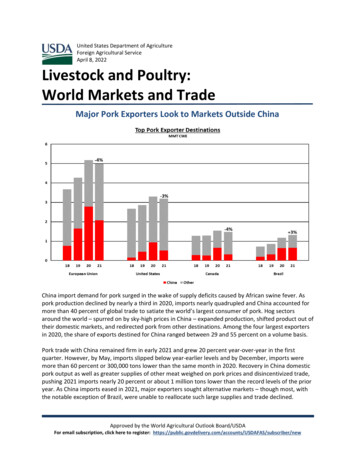
Transcription
United States Department of AgricultureForeign Agricultural ServiceApril 8, 2022Livestock and Poultry:World Markets and TradeMajor Pork Exporters Look to Markets Outside ChinaChina import demand for pork surged in the wake of supply deficits caused by African swine fever. Aspork production declined by nearly a third in 2020, imports nearly quadrupled and China accounted formore than 40 percent of global trade to satiate the world’s largest consumer of pork. Hog sectorsaround the world – spurred on by sky-high prices in China – expanded production, shifted product out oftheir domestic markets, and redirected pork from other destinations. Among the four largest exportersin 2020, the share of exports destined for China ranged between 29 and 55 percent on a volume basis.Pork trade with China remained firm in early 2021 and grew 20 percent year-over-year in the firstquarter. However, by May, imports slipped below year-earlier levels and by December, imports weremore than 60 percent or 300,000 tons lower than the same month in 2020. Recovery in China domesticpork output as well as greater supplies of other meat weighed on pork prices and disincentivized trade,pushing 2021 imports nearly 20 percent or about 1 million tons lower than the record levels of the prioryear. As China imports eased in 2021, major exporters sought alternative markets – though most, withthe notable exception of Brazil, were unable to reallocate such large supplies and trade declined.Approved by the World Agricultural Outlook Board/USDAFor email subscription, click here to register: bscriber/new
In 2022, China pork imports are forecast to decline nearly 20 percent and push global trade lower, morethan offsetting a recovery in demand among other major importing countries as they recover fromCOVID-related disruptions. As growth in other markets will again not offset the decline in China, mostmajor pork exporters will experience a second consecutive year of contracting shipments. The EuropeanUnion (EU), the top pork supplier to China and the world’s largest exporter, is forecast to see exportsdecline 5 percent to just under 4.8 million tons this year. Exporters in the EU are expected to find somerelief from lower China demand in the form of stronger demand in the United Kingdom, where importsare projected 7 percent higher in 2022. The EU will also boost shipments to Japan, South Korea, andAustralia, countries to which EU exports declined in recent years as sales shifted to China. CompetitiveEU carcass prices compared to U.S. and firm demand will propel higher shipments to these markets in2022.Meanwhile, U.S. pork exports are forecast 6percent lower year-over-year. China demandfor U.S. product was among the first to comeunder pressure, with U.S. shipments to thisimportant market falling during every monthof 2021 compared to the previous year dueto high U.S. prices and retaliatory tariffs.These factors are expected to persist in 2022causing further declines in U.S. market share.Partially offsetting losses in China, demandfor U.S. pork is expected to grow in Mexico,the world’s third largest pork importer, where U.S. market share has been consistently higher than 80percent. Tight labor availability in the United States should continue to spur shipments of bone-in hamsto Mexico, which grew 27 percent year-over-year in 2021 and have shown similar strength this year.Additionally, Mexico is well positioned to supply Japan with the labor-intensive cuts it demands, keepingexports as a share of production above 20 percent for the third consecutive year and creating anopportunity for U.S. product to augment domestic consumption. Plus, limitations on Mexico turkeymeat imports due to Highly Pathogenic Avian Influenza discoveries in the United States may also supportincreased pork imports. The United States continues to maintain a position as the dominant supplier toa variety of markets in Latin America that experienced growth in import demand during 2021. Goingforward, Colombia and the Dominican Republic are expected to grow further, although more slowlythan last year as high U.S. prices create headwinds.Canada exports are expected to decline modestly in 2022, sliding 1 percent year over year. Like theUnited States, Canada faces headwinds in China. Currently, the majority of Canada pork productionremains suspended from China due to reported COVID cases at several plants; however, most casesoccurred months ago and do not necessarily represent active outbreaks. Tight supplies in the UnitedStates – Canada’s top export market– will help offset declines to China.Of the four largest exporters, only Brazil saw overall shipments grow in 2021 on strong production gains,competitive prices, and a weak real. Even exports to China increased year over year as Brazil boosted itsshare in that market to 16 percent. In 2022, Brazil is expected to sustain aggregate exports, seeingmodest growth of less than 1 percent. In China, Brazil will likely capture a larger portion of a shrinkingpie due to more competitive pricing than other major exporters. Meanwhile, Brazil continues to performwell in Vietnam and the Philippines and demand is growing in neighboring Argentina and Uruguay.Approved by the World Agricultural Outlook Board/USDAFor email subscription, click here to register: bscriber/newForeign Agricultural Service/USDAGlobal Market Analysis2April 2022
Table of ContentsBeef and VealOverview Beef Summary Tables. .Cattle Summary Tables .457PorkOverview .Pork Summary Tables .Swine Summary Tables .91012Chicken MeatOverview . 14Chicken Meat Summary Tables . 15Notes to Readers 17Livestock and Poultry: World Markets and TradeForeign Agricultural Service/USDAGlobal Market Analysis3April 2022
Beef and VealGlobal production is forecast nearly 1 percent higher in 2022 based on growth in Australia, Brazil,India, and Mexico. High global beef prices will induce more slaughter while greater supplies of cattle andstable carcass weights support the increase in beef production. Australia production is expected toexpand by 12 percent as improved pasture conditions have expedited herd rebuilding over the pastyear. Meanwhile, greater cattle availability and improved slaughterhouse profitability will drive a 4percent increase in Brazil beef production. India carabeef production is forecast up 4 percent, thuscontinuing its recovery and exceeding pre-pandemic levels. Lastly, Mexico is projected to reach recordlevels of production thanks to the cattle sector’s profitability and rebounding hotel, restaurant, andinstitutional demand. Meanwhile, production in Canada, the United States, and European Union areforecast down 3 percent, 1 percent, and 1 percent, respectively. Drought conditions and tight feedavailability in Western Canada will accelerate Canada’s herd contraction. U.S. production is anticipatedto decrease because of a contracting cattle herd as well. Lastly, unprofitability in the EU cattle sector willlead to lower beef production in 2022.Global exports in 2022 are forecast to increase by 3 percent on firm demand, particularly in EastAsia markets. Ample supplies of slaughter-ready cattle and regaining China market access will driveBrazil exports and offset expected declines to Mercosur neighbors. Improved demand from pricesensitive markets will also boost India exports of carabeef to the Middle East and Southeast Asia.Rebounding Australia supplies and firm demand will spur shipments to East Asia and the United States.However, tight cattle supplies in both New Zealand and some Mercosur members (Paraguay, Uruguay,and Argentina) will limit these countries’ exports for 2022.U.S. production and exports: Production is forecast down by about 1 percent as the U.S. herdcontinues to contract leaving a smaller supply of slaughter-ready cattle. Exports are also expected tocontract by 4 percent because of lower production, strong domestic demand, and increased competitionin East Asia. Nevertheless, U.S. exports remain well above historical levels. In 2022, the United States isprojected to remain the world’s largest beef producer and second largest exporter behind Brazil andahead of India and Australia.Source: USDA-FAS-PSDLivestock and Poultry: World Markets and TradeForeign Agricultural Service/USDAGlobal Market Analysis4April 2022
Beef and Veal Production - Top Countries Summary1,000 Metric Tons (Carcass Weight 4406,6706,7206,9806,9207,100European 01,360South 07,0406,9666,969Total Foreign45,47546,26845,34645,40445,80146,066United 73158,65357,73558,13458,18458,693noneTotal Dom. azil7,9257,9297,6117,2427,1407,312European 51,2651,3001,295United ,1018,159Total Foreign43,27043,96743,59443,89643,87344,200United 45156,37656,12556,60156,26356,895Notes: Includes meat of other bovines for certain countries. India includes carabeef (water buffalo). The notation of a month beneath ayear conveys the month in which the forecast for that year was released.Foreign Agricultural Service/USDAGlobal Market Analysis5April 2022
Beef and Veal Trade - Top Countries Summary1,000 Metric Tons (Carcass Weight Equivalent)20182019202020212022Jan2022AprnoneTotal 853832807830825Korea, ed Kingdom502407407407385385Hong Kong521356513371385350European 01,8361,8521,7631,6701,7371,570Total Foreign7,0047,6998,1648,3888,6128,395United 69,6809,90610,0939,955OthersnoneTotal an Union736701714674690685New 20410,0059,9039,88310,56010,267Total ForeignUnited 37811,24211,44712,04311,764Notes: Includes meat of other bovines for certain countries. Indian exports are carabeef (water buffalo). The notation of a monthbeneath a year conveys the month in which the forecast for that year was released.Foreign Agricultural Service/USDAGlobal Market Analysis6April 2022
Cattle Stocks - Top Countries Summary(in 1,000 head)20182019202020212022Jan2022AprnoneTotal Cattle Beg. hina90,38688,79190,82895,00999,50097,559European 83,872889,076902,377919,909917,790Total ForeignUnited duction (Calf 0,75051,90050,52552,50052,500European 08,3008,300Russia6,5666,6806,6606,6006,5256,525New 06611,915Total nited : May contain other bovines. The notation of a month beneath a year conveys the month in which the forecast for that year wasreleased.Foreign Agricultural Service/USDAGlobal Market Analysis7April 2022
Cattle Trade - Top Countries Summary(in 1,000 head)20182019202020212022Jan2022AprnoneTotal ean Union7199432025201501561569610653Total Foreign8541,0981,0591,1691,1011,038United 13,1732,9443,1263,023OthersnoneTotal n 4,2064,5514,201CanadaTotal ForeignUnited ,8764,551Notes: May contain other bovines. The notation of a month beneath a year conveys the month in which the forecast for that year wasreleased.Foreign Agricultural Service/USDAGlobal Market Analysis8April 2022
PorkGlobal production is forecast nearly 3 percent higher year-over-year in 2022 at 110.5 million tonsprimarily on higher output in China. Hog inventories in China continued to grow during 2021 and werereported at nearly 450 million head – up 11 percent year-over-year. This should support China porkproduction in the first half of the year as these animals are marketed. However, currently high inputprices and relatively weak pork demand have pressured producer margins, taking a financial toll on hogoperations and making it likely that output growth will slow later in the year. Overall, China porkproduction is forecast at 51.0 million tons in 2022, 7 percent higher than 2021. In a global context, thiswill offset tighter supplies in the European Union, where a long-term trend of declining consumptioncoupled with slowing export demand drove producer margins down last year. This has led the breedingherd to contract by more than 3 percent. Even with continued growth in sow productivity, EU pigsupplies will be lower as a result, pushing pork production 2 percent lower year-over-year to 23.2 milliontons.Global exports are expected at 11.7 million tons in 2022, 4 percent lower year over year ascontracting China and Philippines imports more than offset growth elsewhere. China imports areforecast to decline 19 percent in 2022 as domestic production continues to grow and consumer demandremains relatively weak. Meanwhile, Philippines imports are forecast down 18 percent due to theexpiration of expanded tariff rate quota volumes and lower tariffs. On the other hand, reboundingfoodservice business is expected to spur South Korea imports 12 percent higher. Mexico imports areexpected to remain firm, growing 4 percent, as pent-up consumer demand and recovering foodservicebusiness supports consumption.U.S. production and exports: U.S. production is forecast at 12.3 million tons in 2022, 2 percentlower than 2021, as lower hog inventories and farrowing intentions lead to tighter pig supplies for theremainder of the year. Meanwhile, tight domestic pork supplies and correspondingly high prices willweigh on U.S. exports while lower imports from China will increase competition in other Asian markets.U.S. exports are forecast to decline 6 percent year over year to just under 3.0 million tons.Source: USDA-FAS-PSDLivestock and Poultry: World Markets and TradeForeign Agricultural Service/USDAGlobal Market Analysis9April 2022
Pork Production - Top Countries Summary1,000 Metric Tons (Carcass Weight pean 081,4511,4841,5401,535Korea, 887110,509Total ForeignUnited StatesTotalnoneTotal Dom. 00European 92,0522,3202,3652,415Korea, South2,0012,0111,9761,9972,0032,034United 75107,193109,080109,830Total ForeignUnited StatesTotalNote: The notation of a month beneath a year conveys the month in which the forecast for that year was released.Foreign Agricultural Service/USDAGlobal Market Analysis10April 2022
Pork Trade - Top Countries Summary1,000 Metric Tons (Carcass Weight Equivalent)20182019202020212022Jan2022AprnoneTotal 01,006932837751740800Korea, 75Hong ,0511,2751,1871,292Total Foreign8,1058,93511,32611,09610,89710,352United 8710,987MexicoUnited KingdomVietnamOthersTotalnoneTotal ExportsEuropean 330Mexico177234344319350320United ia413334384040South 39,0219,1548,694Total ForeignUnited 6712,56512,21012,32911,685Note: The notation of a month beneath a year conveys the month in which the forecast for that year was released.Foreign Agricultural Service/USDAGlobal Market Analysis11April 2022
Swine Stocks - Top Countries Summary(in 1,000 head)20182019202020212022Jan2022AprnoneTotal Beginning 220European 50011,77511,775Korea, 9866,0006,000United 8572,427672,113674,405710,058Total ForeignUnited ion (Pig 00European 81021,75021,700Korea, 9016,77017,23017,00017,25017,150United 119,7111,112,7001,125,983UkraineTotal ForeignUnited 258,203Notes: The notation of a month beneath a year conveys the month in which the forecast for that year was released.Foreign Agricultural Service/USDAGlobal Market Analysis12April 2022
Swine Trade - Top Countries Summary(in 1,000 head)20182019202020212022Jan2022AprnoneTotal ImportsUnited 520European 03122302211782Brazil112221Korea, South211211Total Foreign667451617546595469United 75,9107,2126,3206,969ChinaUkrainenoneTotal n Russia7755443045Ukraine910419105Brazil893223United Kingdom343222Japan000000Korea, 295Total ForeignUnited 350Notes: The notation of a month beneath a year conveys the month in which the forecast for that year was released.Foreign Agricultural Service/USDAGlobal Market Analysis13April 2022
ObustgrowthChicken MeatGlobal production is forecast virtually unchanged in 2022 at 100.1 million tons as gains by majorproducers generally offset declines in Ukraine and China. For most countries, higher feed prices areexpected to stymie expansion despite forecasted economic recovery buoying modest demand growth.As the leading world exporter, Brazil will increase production substantially to backfill global demandvacated as Ukraine meat exports cease. Similarly, expansion in Turkish production will be fueled byregional demand. Russia production will grow on increased availability of feed grains, but product will bedirected to the domestic market. China production is forecast lower as pork production continues torebound and yellow feather broiler production declines due to consumers shifting to online and modernretail channels.Global exports are forecast stagnant in 2022 at nearly 13.4 million tons. Much of the drop in globalexportable supplies spurred by the absence of Ukraine will be fulfilled by Brazil which is one of the fewmajor exporters able to service a wide array of markets. Turkey and the United Kingdom will also posttrade gains on modest demand growth in their respective regions. Imports by Ukraine, Russia, and SaudiArabia will decline while modest growth is expected for Iraq, Cuba, the United Kingdom, and Mexico.U.S. production and exports: U.S. production is forecast 1 percent higher in 2022 as relativelyhigh feed grain prices pressure producer returns and elevated retail prices moderate consumer demand.Exports are forecast unchanged at 3.3 million tons. As U.S. exports are largely destined for pricesensitive middle- and low-income markets, relatively higher U.S. prices will reduce competitivenessparticularly in the second half of the year. While the United States faces restrictions by trading partnersdue to the current Highly Pathogenic Avian Influenza (HPAI) outbreak, these restrictions are generallylimited in geographic scope at a zone, county, or state-level rather than national, thus the impact onshipments to date have been limited.Source: USDA-FAS-PSDLivestock and Poultry: World Markets and TradeForeign Agricultural Service/USDAGlobal Market Analysis14April 2022
Chicken Meat Production - Top Countries Summary1,000 Metric Tons (Ready to Cook na11,70013,80014,60014,70014,30014,300European 82,1712,2152,2902,3002,320United 0,32920,134Total Foreign73,30677,44978,99980,14680,10980,449United l Dom. 40Brazil9,5889,75610,01010,28010,43010,255European ,0252,1172,1302,145United 5,30725,723Total Foreign74,07978,08379,84180,93580,77181,283United 26494,78596,83598,09398,13298,502OthersNotes: Chicken paws are excluded. The notation of a month beneath a year conveys the month in which the forecast for that year wasreleased.Foreign Agricultural Service/USDAGlobal Market Analysis15April 2022
Chicken Meat Trade - Top Countries Summary1,000 Metric Tons (Ready to Cook Equivalent)20182019202020212022Jan2022AprnoneTotal 0875842917940940China342580999789800800United Kingdom779714664625675650European Union740770660644635645Saudi Arabia629601618610625550United Arab Others4,1294,2444,2884,4414,3594,405Total Foreign10,00610,46110,60310,79110,66410,820United ,888TotalnoneTotal n 57460460United 2499,8519,7439,96410,0269,990Total ForeignUnited 11013,11913,32613,42913,352Notes: Chicken paws are excluded. From 2019, Yemen is excluded. The notation of a month beneath a year conveys the month in whichthe forecast for that year was released.Foreign Agricultural Service/USDAGlobal Market Analysis16April 2022
Notes to ReadersThe Livestock and Poultry: World Markets and Trade circular is designed to give a snapshot of the currentsituation among the major players in world beef, pork, and chicken meat trade.Data Revisions in PSDs for Years Prior to 2020:Revisions are made based on new and/or additional tsSlaughter2016 – 20192017 – 2019ChinaAustralia and CanadaProduction1996 – nChicken 19Belarus, Cuba, Egypt, Guatemala, Iraq, Jordan, and VietnamArgentina, South Africa, and VietnamAssumptionsDiseases: Forecast reflects animal disease policies/restrictions in place as of April 8, 2022, and assumestheir continuation.Trade Actions: This report only considers those trade actions which are in place or have had formalannouncement of effective dates as of the time of publication. Further, unless a formal end date isspecified, this report also assumes such actions are in place throughout the time period covered by theseforecasts.Technical NotesCWE/PWE: All quantities (beef and pork) noted are in Carcass Weight Equivalent (CWE) unless otherwisenoted as Product Weight Equivalent (PWE). CWE is the weight of an animal after slaughter and removalof most internal organs, head, and skin. PWE is the actual weight of the meat product exported.RTC (Ready-to-Cook): RTC means any slaughtered poultry free from protruding pinfeathers and vestigialfeathers (hair or down), from which the head, feet, crop, oil gland, trachea, esophagus, entrails, andlungs have been removed, and from which the mature reproductive organs and kidneys may have beenremoved, and with or without the giblets, and which is suitable for cooking without need of furtherprocessing Ready-to-cook poultry also means any cut-up or disjointed portion of poultry or other partsof poultry, such as reproductive organs, head, or feet that are suitable for cooking without need offurther processing.European Union: The term “European Union” means the countries involved in the previous customsunion, i.e., EU27 UK, through 2015. Starting with 2016 data, livestock and poultry PSDs reflect EU27 andUK separately.Livestock and Poultry: World Markets and TradeForeign Agricultural Service/USDAGlobal Market Analysis17April 2022
Conversion Rates and HS CodesBEEF AND VEALHS 50DescriptionBovine carcasses and half carcasses, fresh or chilledBovine cuts bone in, fresh or chilledBovine cuts boneless, fresh or chilledBovine carcasses and half carcasses, frozenBovine cuts bone in, frozenBovine cuts boneless, frozenBovine meat salted, dried or smokedBovine meat, offal nes, not livers, prepared/preserveConversion Rate1.001.001.361.001.001.361.741.79Notes: Beef and veal estimates include meat of other bovines for certain countries. In particular, India estimatesinclude carabeef (water buffalo). Exports of HS 160250 are partially excluded from Argentina export estimates.PORKHS f-carcasses, fr/chBone-In hams, shoulders and cuts thereof, fr/chOther pork cuts, fr/chCarcasses/half-carcasses, frozenBone-In hams, shoulders and cuts thereof, frozenOther pork cuts, frozenBone-In hams, shoulders and cuts thereof, processedBellies (streaky)
in 2020, the share of exports destined for China ranged between 29 and 55 percent on a volume basis. Pork trade with China remained firm in early 2021 and grew 20 percent year-over-year in the first quarter. However, by May, imports slipped below year-earlier levels and by December, imports were




